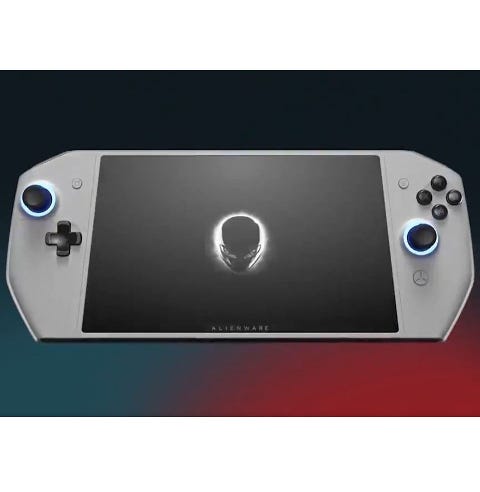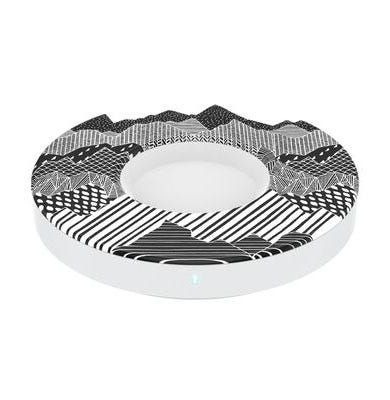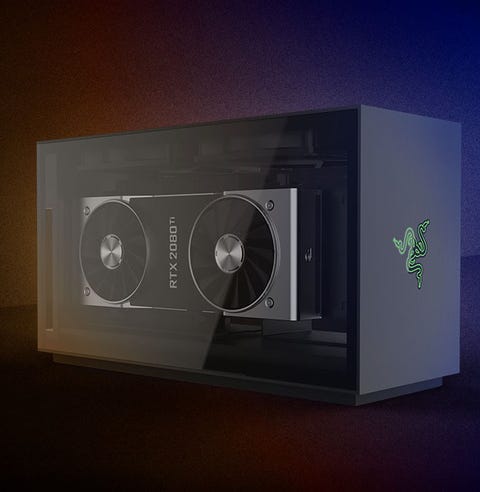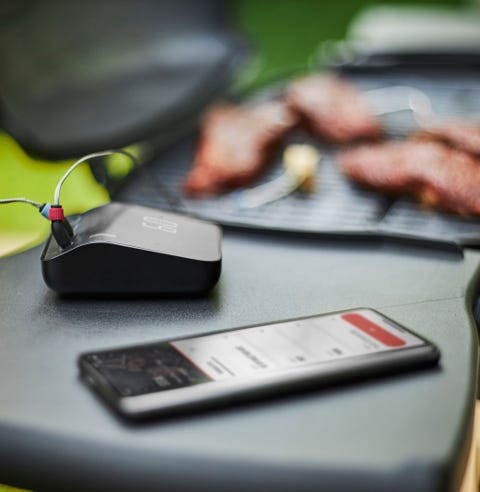We're talking everything from tech to change your living room to tech to change the world.

Exactly one
a decade ago, 4G was the hot new thing, TVs were ugly, and everyone's cell phones slid open. Just imagine what the next ten years will bring. If we really live up to our innovational potential, it'll be a slew of technologies that'll successfully yank our planet away from the precarious edge it is teetering upon. You know, the one where we're about to plunge into irreversible climate disaster. A dark reality!
Let's reign in the doom and gloom for a second thought and focus on the
now.
At the beginning of January, a huge consumer electronics trade show called CES is held in Las Vegas, where companies big and small reveal all the cool new stuff that they've been working on. Much of this stuff is nowhere near being ready to actually sell to actual consumers because it's too outlandish or futuristic or high-concept or all of the above. Still, it's fun to look at. Whereas much of the ready-for-market stuff comes across almost as boring in comparison, but in fact will make our lives more efficient in some neat way or another when it releases. These gadgets below, the 10 most-notable of CES 2020
(according to us), veer into both territories—wacky and useful. Here's a
taste of what this year and years after will have to offer.
And if you're looking for the cool kind of tech that you can buy
right now,
head this way for our favorites gadgets—from earbuds to high-tech jean jackets—of the past year.
There is no way in hell this machine will be hitting asphalt in 2020. It might
never hit the asphalt. Nevertheless, it is both insane and earth-friendly, so therefore important. To create the AVTR, Mercedes-Benz teamed up with
James Cameron and the
Avatar team, hence the name, to brainstorm just how a vehicle can become one with its environment without actually being a plant—and merge with its driver without any prerequisite tail connecting. The answer is the advanced, conceptual technology of AVTR that Mercedes-Benz showcased at CES, ranging from autonomous driving (there's no steering wheel) and a wildly efficient electric battery to neurons that flow around the vehicle to sense passengers' energy. Sure! And the description of this car-ish vehicle keeps getting wilder. It can roll sideways like a crab on rotating wheels. The back is covered with mini solar panels. It recognizes its driver's breathing patterns. It does everything but flies. We're going to have to reimagine how we imagine the future of transportation.
Learn More mercedes-benz.com
We're leaping from the future back to the present, where cannabis is getting prettied-up to ease its path to legalization and social acceptance. The new KEEP storage container for cannabis is discreet on the outside—its display has a clock and weather info—but it opens to reveal multiple storage spaces for different kinds of cannabis products and a rolling tray. The kicker is its locking system, which
works via facial recognition or a data-encrypted app. If someone who isn't you is trying to get into your stash, then you'll get a
notification, which is very practical if you have houseguests, kids, or greedy roommates. KEEP is available for
pre-order
now for $152, with shipments loosely planned to go out in the spring.
(Ironically, Keep Labs was given an innovation award by CES but barred from using cannabis imagery or verbiage at CES, so it skipped the show.
Cannabis acceptance comes in fits and spurts.)
Learn More discoverkeep.com
CES is always big on TV announcements, and especially worth noting is Samsung's new Sero TV because its defining feature goes beyond LED and 4K and what have you. It seems so obvious: a TV that transitions from the horizontal plane to the
gasp, vertical plane. That's what Samsung is doing with The Sero, which means
"vertical" in Korean. This QLED TV, already available in South Korea and
going global this year, flips so that longways it resembles a 43-inch
phone screen. That means it's ideal for mirroring an Instagram or TikTok feed from your Galaxy phone, should you have one. What a trick. And here you hoped you’d be looking at your phone screen less in 2020.
Learn More samsung.com
One of LG's 2020 TVs transitions from horizontal to non-existent
by rolling down into its base when it's not needed. LG debuted this
OLED 4K HDR smart television at CES last year and this year confirmed that the thing will go on sale in the U.S. sometime in 2020. And all you need is a rumored $60,000, according to
CNET.
Yep, $60,000 for a 65-inch TV that blocks and then unblocks a view,
epitomizing the phrase "less screen time" but still leaving you with a
not-insignificant base to contend with. At least that screen is roll-tested to ensure the best quality (i.e. no breakage or dents) for years. Either way, when one CES TV flips and another disappears altogether, we know tech companies are getting funky with how we watch television.
Learn More lg.com
The selling point for this gaming gadget is simple: It's the
Nintendo Switch of PC gaming, with detachable cons, a "bridge" to connect those two detached cons to make one big controller, an eight-inch display, and a kickstand to prop up the screen. But most significantly, Alienware compares its power to that of a PC gaming device to support games that the Switch won't. Unfortunately, though,
it's just a concept with no concrete plans for production or rollout, so you're stuck with the Switch library or your phone for the time being.
Learn More twitter.com
This gadget should’ve debuted at least a year ago. If you've
bought into PopSocket culture, you know it's basically impossible to
charge a newer smartphone with a PopGrip on the back using a wireless,
Qi-enabled charger without having to remove the PopGrip, which is a pain in the ass. So PopSocket released its solution, timed to CES: a
wireless charger with a little crevice hollowed out on the surface for the PopGrip to fit snuggly into without impeding the charging process.
They're $60 each, and they're currently sold out. Apparently, there were
a lot of frustrated PopSocketers out there.
Learn More popsockets.com
Just when you'd thought you were paying for every streaming service available to mankind, another one pops up. As Quibi preps itself for an April 6 debut on smartphones, but not televisions, it gave a
keynote address at CES to explain itself. The cliff notes version: It's a
subscription-based service with original programming for phone viewing
only.
For example, its movies could be segmented into 10-minute clips, or shows could have short-enough episodes to view easily on the go. Some of the content was shot in a way so that if you flip your phone while watching it, you'll get a different perspective. And
Quibi has big-name actors signed on for mysterious projects,
like Chrissy Teigen, Zac Efron, Idris Elba, and Steph Curry. If you're sold—or even just a tiny bit curious as to how this is different from
Netflix—you can expect to pay $5 a month for Quibi with ads and $8 a
month for Quibi sans ads.
Learn More quibi.com
Folding screens are so hot right now. They’re just not very practical, mainly because, as in the case with the Samsung Galaxy Fold,
they feel as if a firm shake will shatter their screens. But there’s room to grow and improve, as exhibited by Lenovo’s new foldable PC
laptop, the ThinkPad X1 Fold. There are a lot of configurations in which to use it, and should you need a more traditional laptop set-up, it comes with a mini keyboard attachment that folds into the machine. The
The OLED display is 13.3 inches, the machine is 2.2 pounds, and the hinge in supposedly stress-tested. Lenovo plans to get it out mid-2020, starting at $2,499.
Learn More lenovo.com
This DIY desktop PC is probably unlike one you've seen before,
mainly because it's smaller than the big, honking, build-your-own PCs available now. Razer's new Tomahawk is modular, so you can pop parts into place—no tools required, so Razer says—with a powerful and very compact Intel computer and impressive graphics for gaming. It's not meant to stress you out with too many wires or configurations if you don't happen to be a PC gaming whiz. Razer also emphasizes its portability, its upgrade potential, and its diminutive size
(comparatively speaking), but doesn't yet mention a price or release date.
Learn More razer.com
This is a fun one: Weber invented a $130 device that attaches to your grill and syncs with your smartphone so you can better monitor the temperature and done-ness of your meat and veggies. That means notifications and information through a Weber app. If you dub yourself a
"grill master" while using it, that
does count as cheating. However, the food will speak for itself.
Learn More weber.com
The Hydraloop is not particularly sexy, but neither is conserving water. It's just common sense at this point. This device—it's big, like a refrigerator—recycles and cleans about 85 percent of the water you use in your home, while its app keeps you updated on the recycling process and your total water usage. For showers, for dishes,
for laundry, for the pool, whatever. Pre-orders are open now, starting at $4,000. The upfront cost is significant, but your bills will probably go down and your house will be a model of efficient living, one all the neighbors can envy.
Learn More hydraloop.com















0 Comments